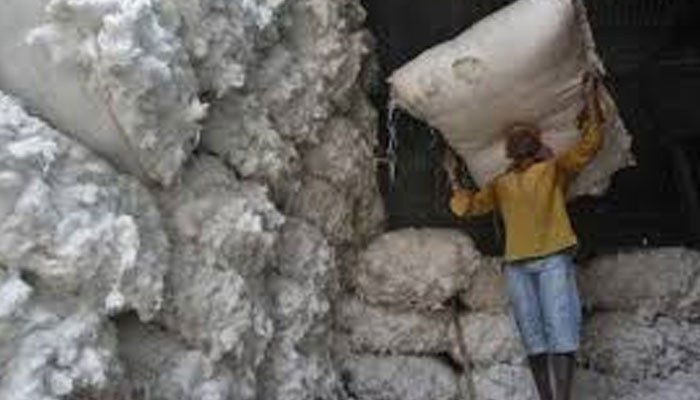Cotton stockpiles fall record 43 percent; imports likely to surge
KARACHI: Cotton stockpiling fell a massive 43 percent to 3.45 million bales till October 31, raising concerns that the country would have to import at least 7.0 million bales worth $3 billion to fulfil domestic demand, industry officials said on Tuesday.
Cotton arrivals declined 43.38 percent to 3.45 million bales against 6.09 million bales in the same month last year, as heavy monsoon along with sowing substandard seeds took a toll on total yields, said the last report released by Pakistan Cotton Ginners Association (PCGA).
Punjab and Sindh showed declines of 45 percent and 41 percent respectively in cotton production during the period under review. Both provinces had stocked 1.7 million bales each till the end of October. Last year, Punjab and Sindh stocked 3.16 million and 2.92 million bales, respectively.
Karachi Cotton Brokers Association Chairman Naseem Usman said that a decline of 2.6 million bales in cotton arrivals was a point of concern. “Total expected cotton arrivals are around 5.5 million bales, and there would be need to import at least 7.0 million bales, as consumption demand of local mills was around 14 million bales.”
An import of 7.0 million bales would cost nearly $3 billion to the country.
Fortnightly flows (October 15-31) remained down by 54 percent at 763,997 bales against flows of 1.65 million bales during the same period last year.
Till October 2020, textile companies bought 2.5 million bales while exporters bought 17,600 bales (down 58 percent from 41,960 bales last year). Mills have acquired 2.57 million bales, which showed a decline of 42 percent from last year’s 4.42 million bales.
Stakeholders said the major reason behind steep fall in production of cotton was unavailability of good quality seeds, absence of new seed technology, heat waves, climate change, and pest attacks.
Mirpur Khas and Sanghar districts in Sindh incurred huge losses on account of heavy monsoon rains. As a result, the province suffered 25 percent crop loss. In Punjab, the affected districts were DG Khan, Muzzafar Garh, Rajanpur and Multan.
Despite the fact that cotton is an important cash crop, which contributes significantly to the national economy by providing raw material to the local textile industry, as well as cotton lint for export, policy makers failed to introduce quality seeds in the country.
Currently, 864,245 bales are in stocks with ginners, down 47 percent, compared to 1.62 million bales last year.
In the last decade, cultivation in core cotton zones declined due to unwarranted increase in sugarcane production. With setting up of sugar factories in core cotton districts including Multan, Lodhran, Khanewal, Vehari, Muzaffargarh, Layyah, DG Khan, Rajanpur, Bahawalpur, Bahawalnagar and RY Khan, cotton area under cultivation has been on the decline, further reducing output in the country.
On the other hand, plantations of cotton in non-core districts like Faisalabad, Toba Tek Singh, Jhang, Okara, Sahiwal and Pakpattan faced massive pest attack due to obsolete production technology and impure seeds.
-
 Prince Harry Urges His Pals Are ‘not Leaky,’ He Is Not ‘Mr Mischief’
Prince Harry Urges His Pals Are ‘not Leaky,’ He Is Not ‘Mr Mischief’ -
 What Prince William And Kate Think Of Brooklyn's Attack On Victoria And David Beckham?
What Prince William And Kate Think Of Brooklyn's Attack On Victoria And David Beckham? -
 Meghan Trainor Reveals Why Surrogacy Was The 'safest' Choice
Meghan Trainor Reveals Why Surrogacy Was The 'safest' Choice -
 Victoria Beckham Supports Youngest Son In First Move Since Brooklyn's Rebellion
Victoria Beckham Supports Youngest Son In First Move Since Brooklyn's Rebellion -
 'Percy Jackson' Star Feels Relieved After Season Two Finale
'Percy Jackson' Star Feels Relieved After Season Two Finale -
 Jelly Roll Reveals How Weight Loss Changed Him As A Dad: 'Whole Different Human'
Jelly Roll Reveals How Weight Loss Changed Him As A Dad: 'Whole Different Human' -
 Prince Harry Gets Emotional During Trial: Here's Why
Prince Harry Gets Emotional During Trial: Here's Why -
 Queen Camilla Supports Charity's Work On Cancer With Latest Visit
Queen Camilla Supports Charity's Work On Cancer With Latest Visit -
 Dove Cameron Opens Up About Her Latest Gig Alongside Avan Jogia
Dove Cameron Opens Up About Her Latest Gig Alongside Avan Jogia -
 Petition Against Blake Lively PGA Letter Gains Traction After Texts With Taylor Swift Revealed
Petition Against Blake Lively PGA Letter Gains Traction After Texts With Taylor Swift Revealed -
 Netflix Revises Warner Bros. Deal To $83 Billion: All-cash Offer
Netflix Revises Warner Bros. Deal To $83 Billion: All-cash Offer -
 Prince Harry Mentions Ex-girlfriend Chelsy Davy In UK Court
Prince Harry Mentions Ex-girlfriend Chelsy Davy In UK Court -
 David, Victoria Beckham 'quietly' Consulting Advisers After Brooklyn Remarks: 'Weighing Every Move'
David, Victoria Beckham 'quietly' Consulting Advisers After Brooklyn Remarks: 'Weighing Every Move' -
 Meta's New AI Team Delivered First Key Models
Meta's New AI Team Delivered First Key Models -
 Prince Harry Defends Friends In London Court
Prince Harry Defends Friends In London Court -
 AI May Replace Researchers Before Engineers Or Sales
AI May Replace Researchers Before Engineers Or Sales




